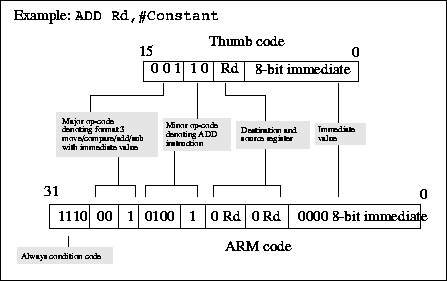The Thumb Extension
The ARM processor has found its greatest uses in embedded systems,
hand-held computers, and other systems where there is a high requirement
for systems to do a lot of work with limited resources. The Thumb
extension was created to address some of these aspects of resource
consumption, and it has become a standard extension on nearly all ARM
chips produced today.
One of the resources that is limited on small systems is instruction
memory. Limited instruction memory limits the size of the program you can
run on your processor, so you want to look for ways to reduce the size of
your code. Compile-time optimizations are one obvious way to achieve
this, when such optimizations can be found. Increasing the size of the
instruction set is another way to do it, but this normally results in an
increase in the size of individual instructions across the board, which
will lead to a corresponding increase in the amount of storage needed to
store the instructions, which may not be offset by the reduction in the
number of instructions needed to write the program.
The quality we're looking for is called code density. We want to
somehow do the same amount of work, yet have the program take up less
space. This is where the Thumb extension comes in. Thumb tries to get
the best of both worlds by allowing a large (32-bit) instruction set while
providing an alternate, small (16-bit) instruction set that can do the
bulk of the work while taking up only half the space. They call this
concept "code compression", the idea being that the small Thumb
instructions are "decompressed" to their equivalent full-size 32-bit ARM
instructions before they are run.
What do Thumb instructions look like, and how do they compare to their 32-bit counterparts?
The illustration below shows an example of how the ADD instruction is
converted from Thumb to ARM. Notice how the immediate operand, 8 bits in
Thumb, is padded with zeroes in its ARM equivalent. Note also that the add instruction takes an additional operand when decompressed.

A smaller instruction means you must have smaller opcodes, and fewer or
smaller (or both) operands. Thumb ensures smaller operands in part by
restricting most of its instructions to use 8 general purpose registers in
place of the usual 15. A few instructions can access the full register
set, such as MOV, to enable workarounds to some of the limitations of a
smaller register set.
How does the ARM know whether the instruction it's running is a Thumb
instruction or a regular ARM instruction?
The ARM chip contains a special state bit that tells the CPU whether to
expect a compressed Thumb instruction or a standard ARM instruction. This
bit is toggled with its own instruction, BX, which must be insterted into
the code every time a programmer or compiler wishes to switch between
Thumb mode and Standard ARM mode. An obvious result of this is that there
is some overhead to switching between modes, thus it is probably not a
good idea to switch to Thumb unless it will save you more than two
instructions of equivalent ARM code.
